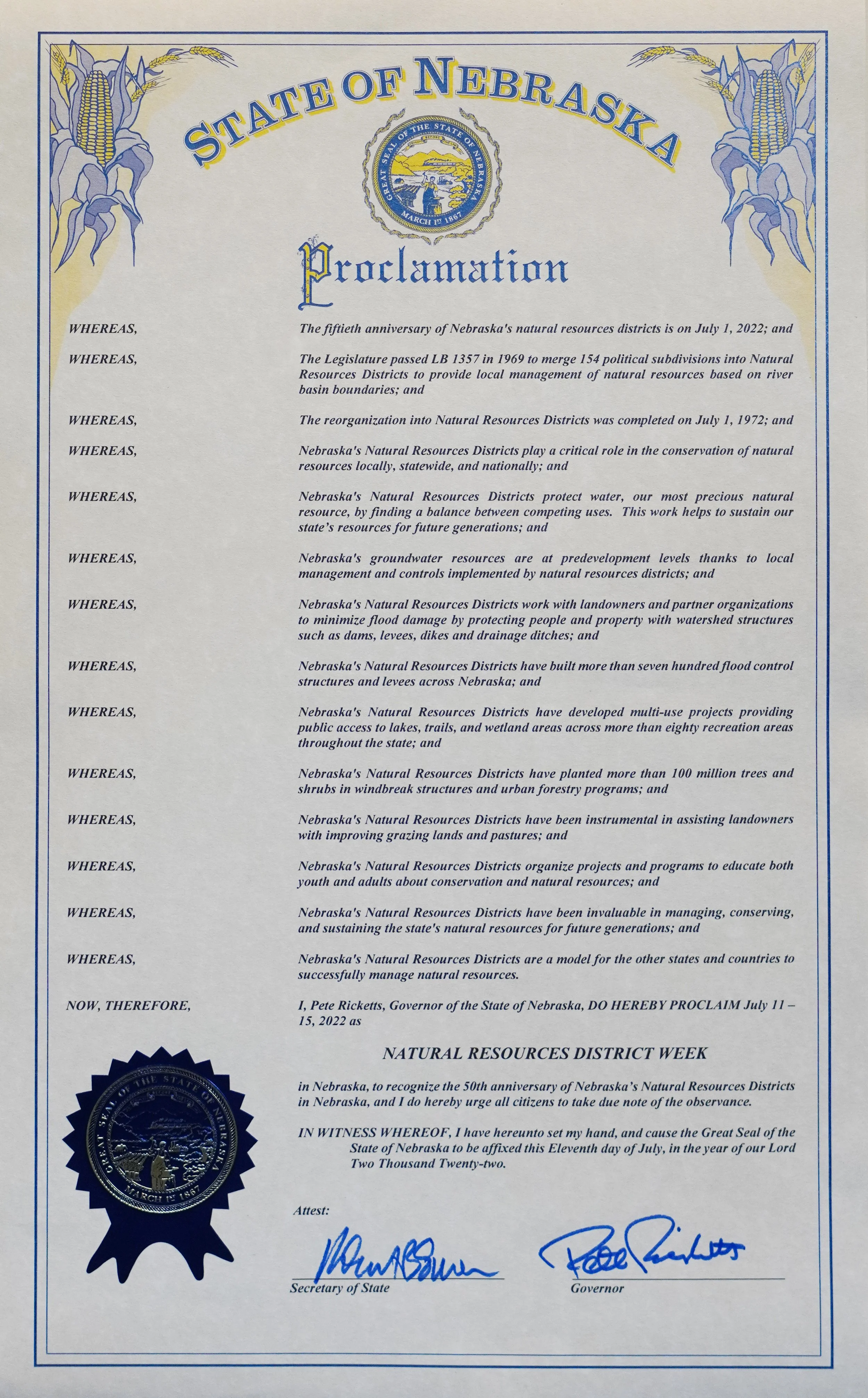Governor Ricketts Proclaims July 11-15 as NRD Week
/The Nebraska Association of Resources Districts (NARD) Executive Committee make NRD Week (July 11-15, 2022) official with a proclamation from Gov. Pete Ricketts. From left, NARD Past President Jim Eschliman (Lower Loup NRD), NARD Executive Director Dean Edson, NARD President Dr. Orval Gigstad (Nemaha NRD), NARD Secretary/Treasurer Joel Hansen (Lower Elkhorn NRD), and NARD Vice President Martin Graff (Middle Niobrara NRD).
LINCOLN, Nebraska – With the swoosh of a pen and eager applause, Gov. Pete Ricketts proclaims July 11-15, 2022, as NRD Week in Nebraska to celebrate Nebraska’s Natural Resources Districts (NRDs) 50th anniversary.
“We are proud to celebrate five decades of protecting, conserving and improving Nebraska’s nature resources,” said Dr. Orval Gigstad, Nebraska Association of Resources Districts president. “It’s amazing to see the conservation progress that has been made these last 50 years and NRD directors and staff know the work we do today – planting trees, water management, soil health – will directly impact our future.”
After the devastation of the Dust Bowl, special purpose districts were developed to solve local soil and water-related problems. But the puzzle of overlapping authorities and responsibilities provided confusion at best.
In 1969, Senator Maurice Kremer introduced legislative bill 1357 to combine Nebraska’s 154 special purpose entities into 24 Natural Resources Districts by July 1972. In 1989, The Middle Missouri Tributaries NRD and the Papio NRD merged to become the Papio-Missouri River NRD resulting in today’s 23 Natural Resources Districts.
Today, Nebraska’s unique system of locally controlled, watershed-based conservation is widely admired throughout the nation.
NRDs deliver several state and federal programs including many projects with the U.S. Department of Agriculture Natural Resources Conservation Service (NRCS), Nebraska Department of Environment and Energy (NDEE), Nebraska Department of Natural Resources (NeDNR) and the University of Nebraska. These partnerships equate into real dollars for Nebraska agriculture and communities.
“Nebraska policymakers had incredible foresight when creating the NRDs realizing that our strength lies in collaboration with partners to champion conservation,” Dr. Gigstad said. “Our partnerships with local, state and federal agencies have helped deliver conservation to millions of acres reducing soil loss and improving water quality and quantity.”
Across the state, Natural Resources Districts construct projects, implement programs and aid landowners in conservation and natural resources management. When necessary, they enact regulations to protect our resources. While all NRDs share the 12 main responsibilities, each district sets its own priorities and develops its own programs to best serve and protect Nebraska’s natural resources. Often the most recognizable NRD responsibilities include groundwater management, flood protection and conservation trees.
Governor Rickets signs the proclamation.
Groundwater Management
Nebraska’s Natural Resources Districts are responsible for protecting one of our most precious resources – groundwater. This mean ensuring there is enough for all users and protecting it from pollution.
As the No. 1 irrigated state in the nation, managing Nebraska’s water to ensure there is enough for domestic, industrial and agricultural purposes is essential. NRDs work with irrigators to monitor water use, establish groundwater recharge projects, and implement water-wise programs. This is especially important during times of drought.
NRDs have been developing groundwater quality plans since the 1980s, which are an essential part of protecting our water. Addressing groundwater quality issues requires regular data collection and recognizing and planning for changing conditions. Regulatory and taxing authorities allow NRDs to develop locally based incentive and educational programming and to enforce regulations when needed to protect Nebraska’s groundwater today and into the future.
Flood Protection
From Gering Valley in the Nebraska Panhandle to Papillion Creek in the Omaha metro, NRDs across the state employ a watershed protection approach. Utilizing floodplain management measures, NRDs design and build dams, levees, dikes, drainage ditches and other structures to keep flood waters from taking lives or damaging crops, buildings and roads.
Flood control projects are developed for multiple purposes and often provide the additional benefit of recreation including activities such as boating, fishing, camping, wildlife viewing and pedestrian trails. Trails are built atop levees and flood-control reservoirs often develop into recreation areas. Habitat areas and wetlands are available for hunters and often preserved for interpretative nature study.
Conservation Tree Program
This spring, the NRD Conservation Tree Program planted its 100 millionth tree – that’s approximately 50 trees for each Nebraskan. Annually, the NRD Conservation Tree Program provides hundreds of thousands of low-cost, bulk trees and shrubs for windbreaks, erosion control, wildlife habitat and other conservation purposes. Districts collect orders for trees between November and March, then trees are distributed in April for spring planting.
Natural Resources Districts’ staff and directors will plant the ceremonious 100 millionth tree on the Nebraska Capitol grounds in a public ceremony this fall.
Dr. Gigstad noted that Nebraska’s NRDs will continue to adapt to meet future conservation needs.
“Protecting our precious resources like soil and water is something we can all agree on,” he said. “NRDs are uniquely positioned to help manage our natural resources to protect lives, property and the future of Nebraska’s communities.”
To join in the 50th anniversary celebration and follow the Natural Resources Districts’ special activities throughout 2022, visit www.nrdnet.org and follow #Since1972 on social media.
The Nebraska Association of Resources Districts (NARD), the trade association for Nebraska's 23 Natural Resources Districts (NRD), works with individual districts to protect lives, property and the future of Nebraska’s natural resources. NRDs are unique to Nebraska, and act as local government entities with broad responsibilities to protect Nebraska’s natural resources. Major Nebraska river basins form the boundaries of the 23 NRDs, enabling districts to respond to local conservation and resource management needs. Learn more about Nebraska’s NRDs at www.nrdnet.org.



